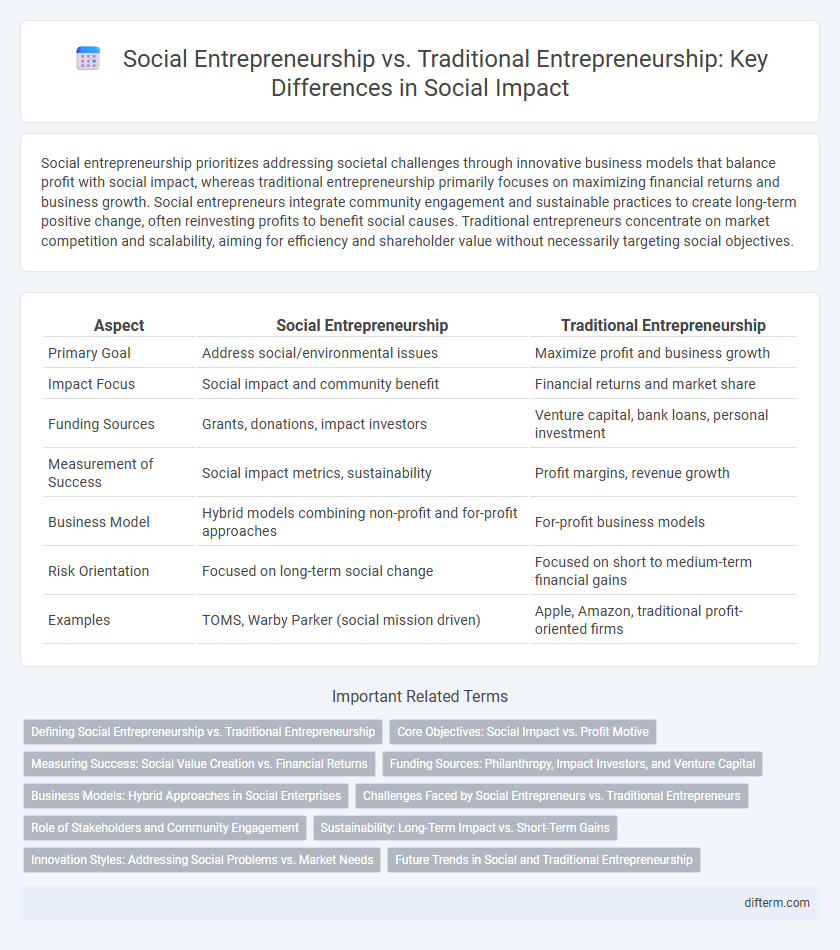Social entrepreneurship prioritizes addressing societal challenges through innovative business models that balance profit with social impact, whereas traditional entrepreneurship primarily focuses on maximizing financial returns and business growth. Social entrepreneurs integrate community engagement and sustainable practices to create long-term positive change, often reinvesting profits to benefit social causes. Traditional entrepreneurs concentrate on market competition and scalability, aiming for efficiency and shareholder value without necessarily targeting social objectives.
Table of Comparison
| Aspect | Social Entrepreneurship | Traditional Entrepreneurship |
|---|---|---|
| Primary Goal | Address social/environmental issues | Maximize profit and business growth |
| Impact Focus | Social impact and community benefit | Financial returns and market share |
| Funding Sources | Grants, donations, impact investors | Venture capital, bank loans, personal investment |
| Measurement of Success | Social impact metrics, sustainability | Profit margins, revenue growth |
| Business Model | Hybrid models combining non-profit and for-profit approaches | For-profit business models |
| Risk Orientation | Focused on long-term social change | Focused on short to medium-term financial gains |
| Examples | TOMS, Warby Parker (social mission driven) | Apple, Amazon, traditional profit-oriented firms |
Defining Social Entrepreneurship vs. Traditional Entrepreneurship
Social entrepreneurship prioritizes creating positive societal impact and addressing social issues through innovative solutions, often reinvesting profits into community development. Traditional entrepreneurship primarily focuses on profit maximization, market growth, and shareholder value without necessarily targeting social change. The key distinction lies in social entrepreneurship's mission-driven approach versus traditional entrepreneurship's profit-driven model.
Core Objectives: Social Impact vs. Profit Motive
Social entrepreneurship prioritizes addressing societal challenges by creating sustainable solutions that generate positive social impact, often reinvesting profits to expand their mission. Traditional entrepreneurship focuses primarily on maximizing financial returns for stakeholders, emphasizing profit generation and market growth. The core objective of social ventures lies in balancing economic viability with measurable social benefits, whereas traditional businesses prioritize revenue and shareholder value.
Measuring Success: Social Value Creation vs. Financial Returns
Social entrepreneurship measures success primarily by the social value created, emphasizing community impact, environmental sustainability, and long-term societal benefits. Traditional entrepreneurship focuses on financial returns, prioritizing profit margins, revenue growth, and shareholder value. Metrics such as social impact assessments, beneficiary reach, and sustainability indicators are crucial in evaluating social ventures, contrasting with financial statements and ROI benchmarks in traditional businesses.
Funding Sources: Philanthropy, Impact Investors, and Venture Capital
Funding sources for social entrepreneurship often include philanthropy and impact investors who prioritize social and environmental returns alongside financial gains. Traditional entrepreneurship primarily relies on venture capital focused on maximizing financial profits and scalable market growth. Social entrepreneurs blend grants, donations, and impact-driven investment to sustain ventures with measurable societal benefits, contrasting with the profit-driven funding typical in traditional startups.
Business Models: Hybrid Approaches in Social Enterprises
Social enterprises adopt hybrid business models that blend profit-driven strategies with social impact objectives, diverging from traditional entrepreneurship focused solely on financial returns. These models integrate revenue-generating activities with mission-driven initiatives, enabling sustainable funding while addressing community needs. Key examples include cross-subsidization, where profitable products support social programs, and impact investing that aligns market success with social value creation.
Challenges Faced by Social Entrepreneurs vs. Traditional Entrepreneurs
Social entrepreneurs face unique challenges such as securing funding from impact-driven investors and balancing social missions with financial sustainability, whereas traditional entrepreneurs primarily focus on profit maximization and market competition. Navigating complex stakeholder expectations and measuring social impact metrics often complicates decision-making for social ventures compared to traditional businesses. Social entrepreneurs also encounter regulatory and legal barriers tailored to non-profit and hybrid models, which differ significantly from the challenges faced by traditional profit-oriented enterprises.
Role of Stakeholders and Community Engagement
Social entrepreneurship prioritizes active stakeholder involvement and deep community engagement to address social challenges, fostering collaborative problem-solving and sustainable impact. Traditional entrepreneurship primarily focuses on shareholder value and profit maximization, often limiting direct community participation in decision-making processes. Engaging diverse stakeholders enhances social ventures' legitimacy, resource access, and accountability, driving long-term social change beyond economic outcomes.
Sustainability: Long-Term Impact vs. Short-Term Gains
Social entrepreneurship prioritizes sustainability by emphasizing long-term impact on communities and environments, integrating social and environmental goals into core strategies. Traditional entrepreneurship often focuses on short-term financial gains and market growth, sometimes overlooking broader societal or ecological effects. This distinction shapes how resources are allocated, with social ventures reinvesting profits to address systemic issues, promoting resilience and lasting change.
Innovation Styles: Addressing Social Problems vs. Market Needs
Social entrepreneurship prioritizes innovative solutions that directly address pressing social problems, leveraging community engagement and sustainable impact strategies. Traditional entrepreneurship focuses on market needs by developing products or services that maximize profit and competitive advantage within established economic sectors. This distinction highlights how social entrepreneurs drive change through mission-driven innovation, while traditional entrepreneurs emphasize market-driven innovation for financial growth.
Future Trends in Social and Traditional Entrepreneurship
Future trends in social entrepreneurship emphasize scalable impact through technology-driven solutions addressing global challenges like climate change and social inequality. Traditional entrepreneurship is increasingly integrating sustainability and ethical practices to meet evolving consumer demands and regulatory standards. Both models are converging towards hybrid business structures that balance profit generation with social value creation.
social entrepreneurship vs traditional entrepreneurship Infographic

 difterm.com
difterm.com